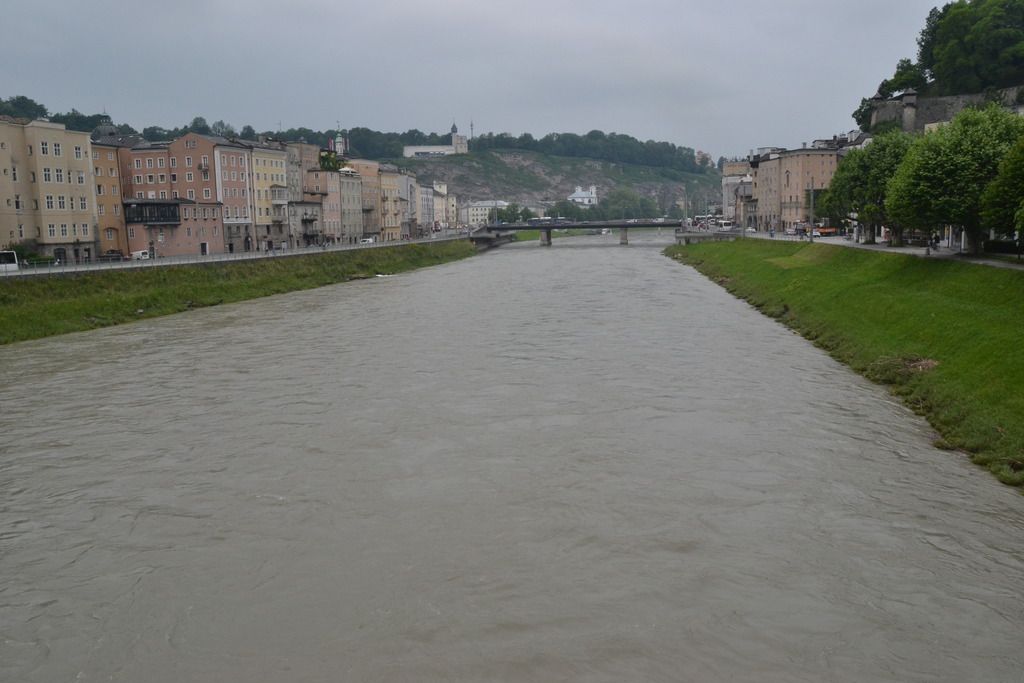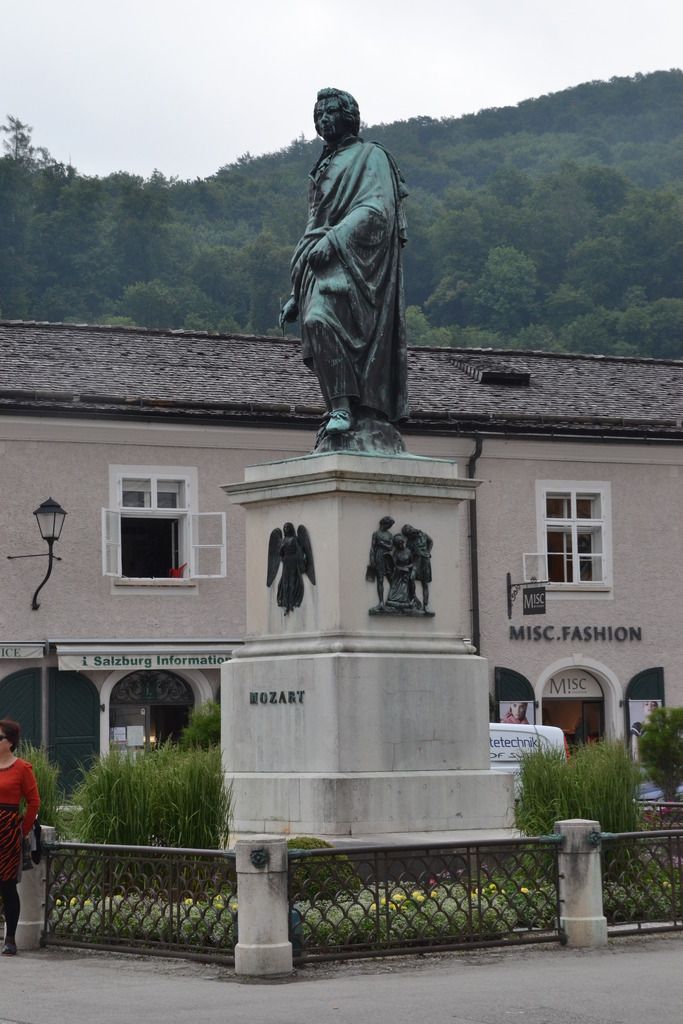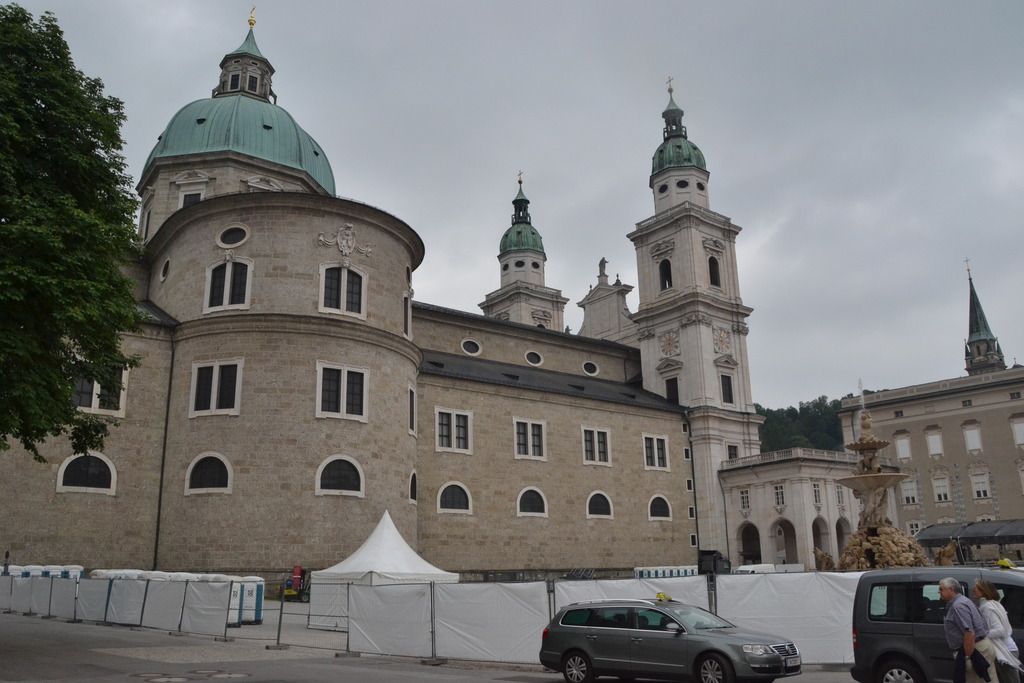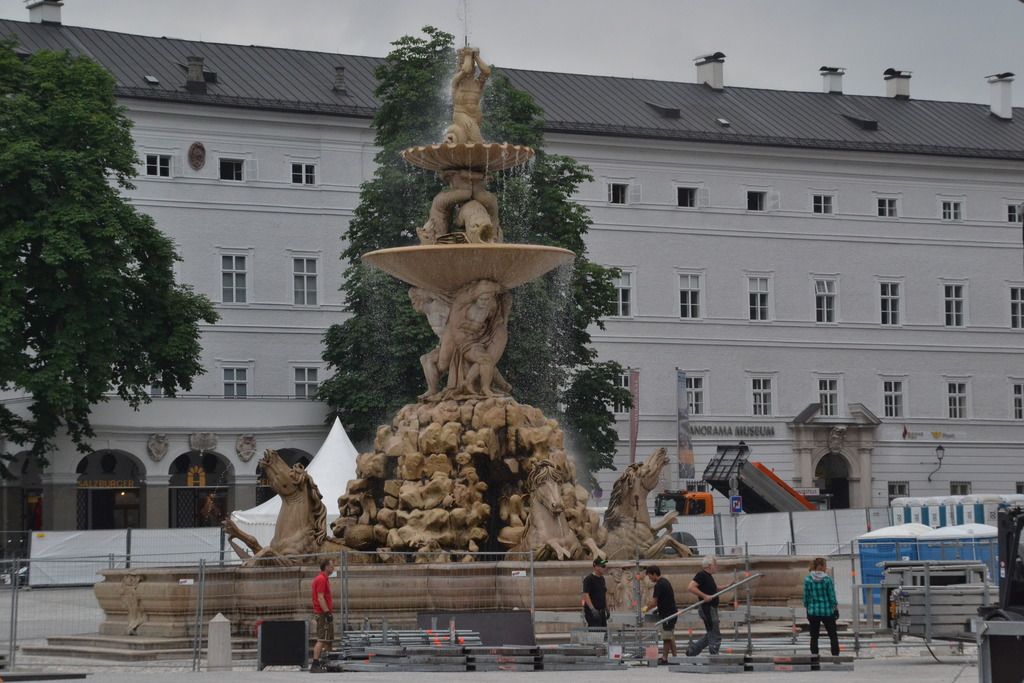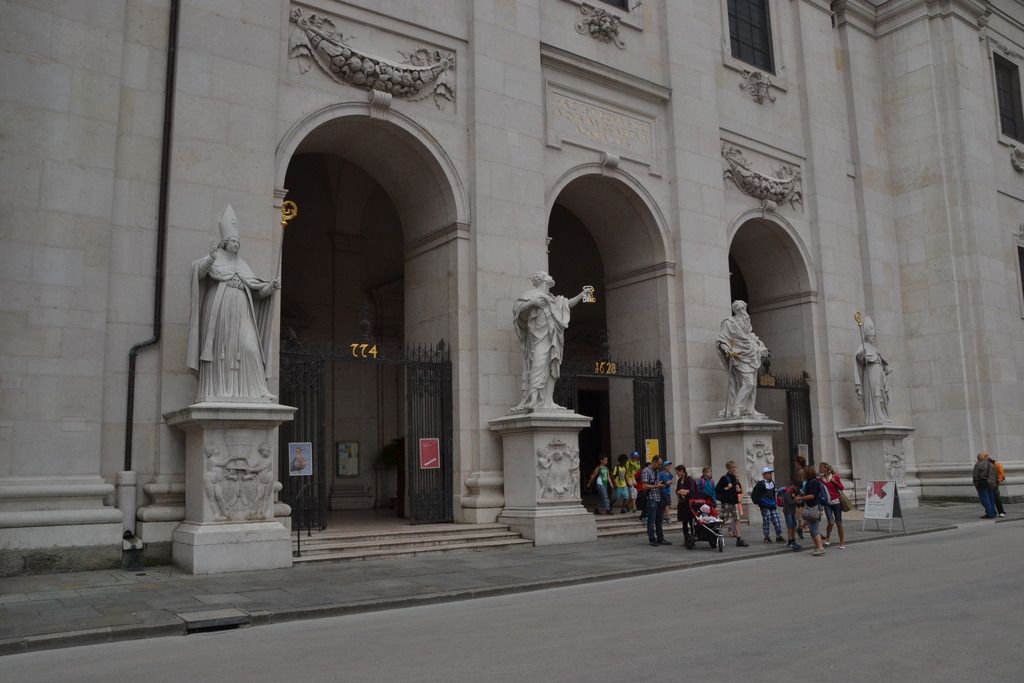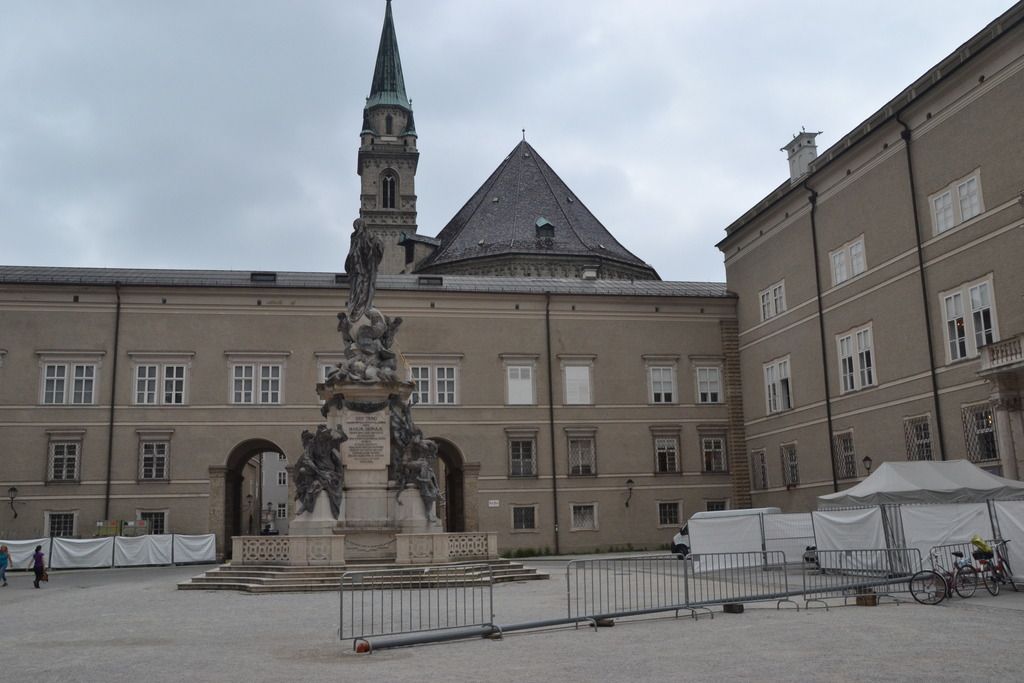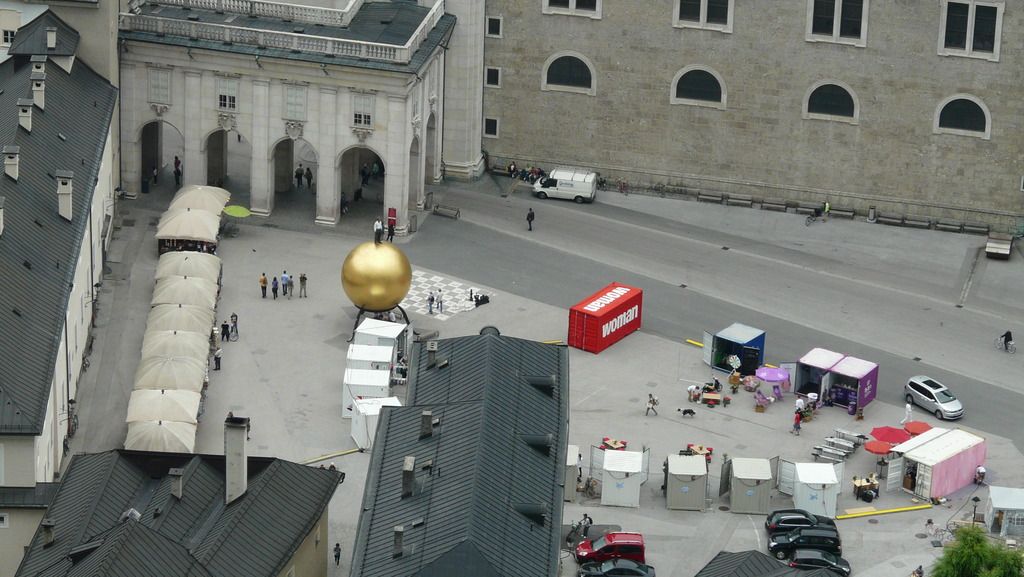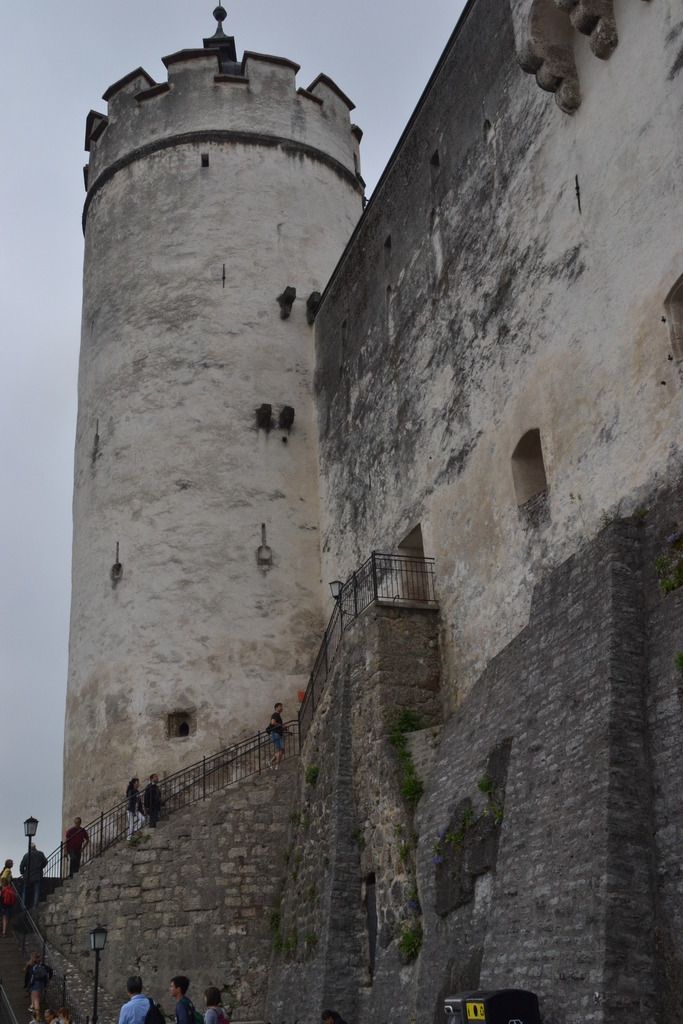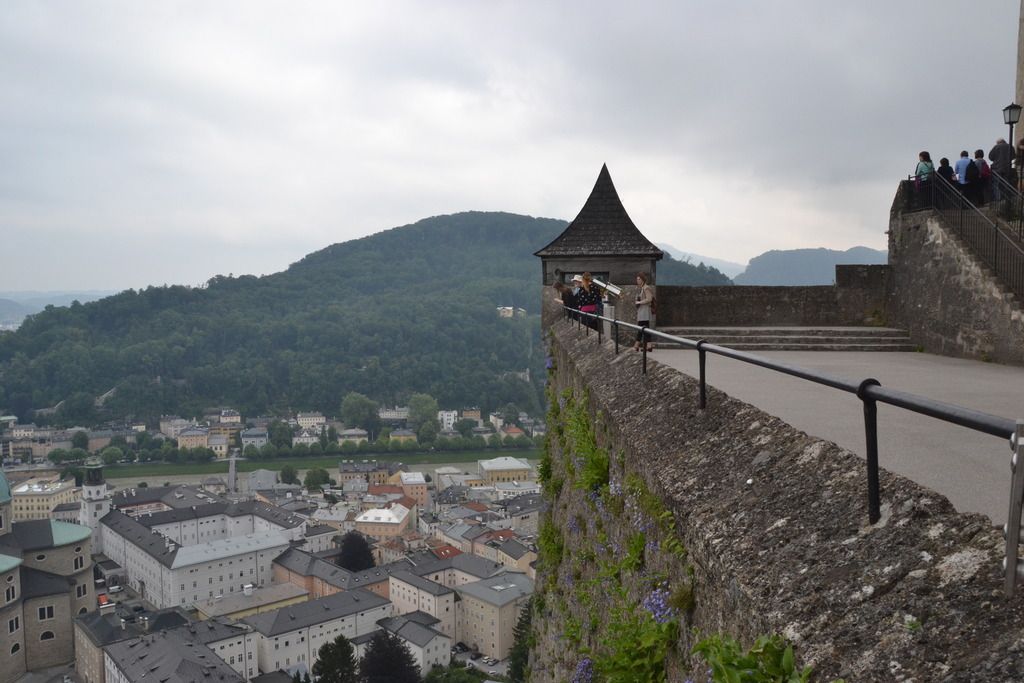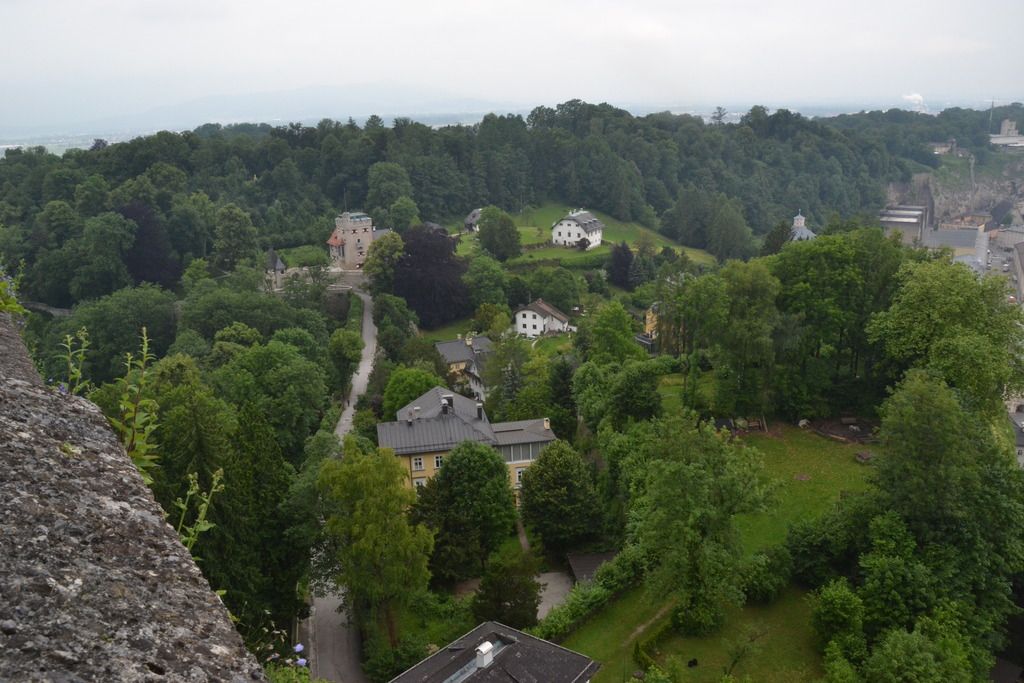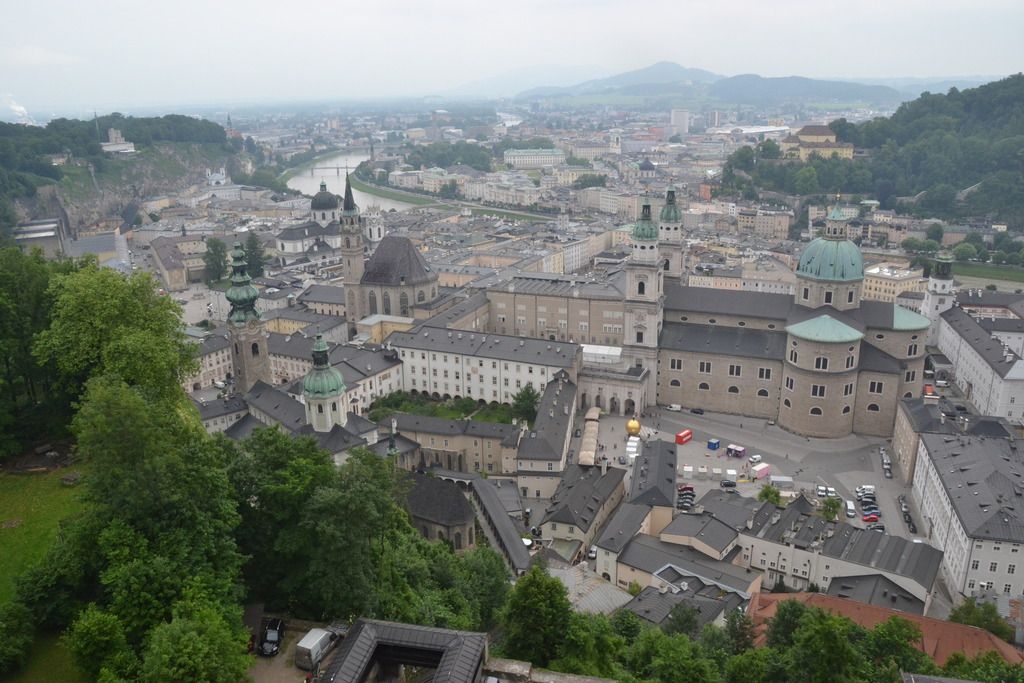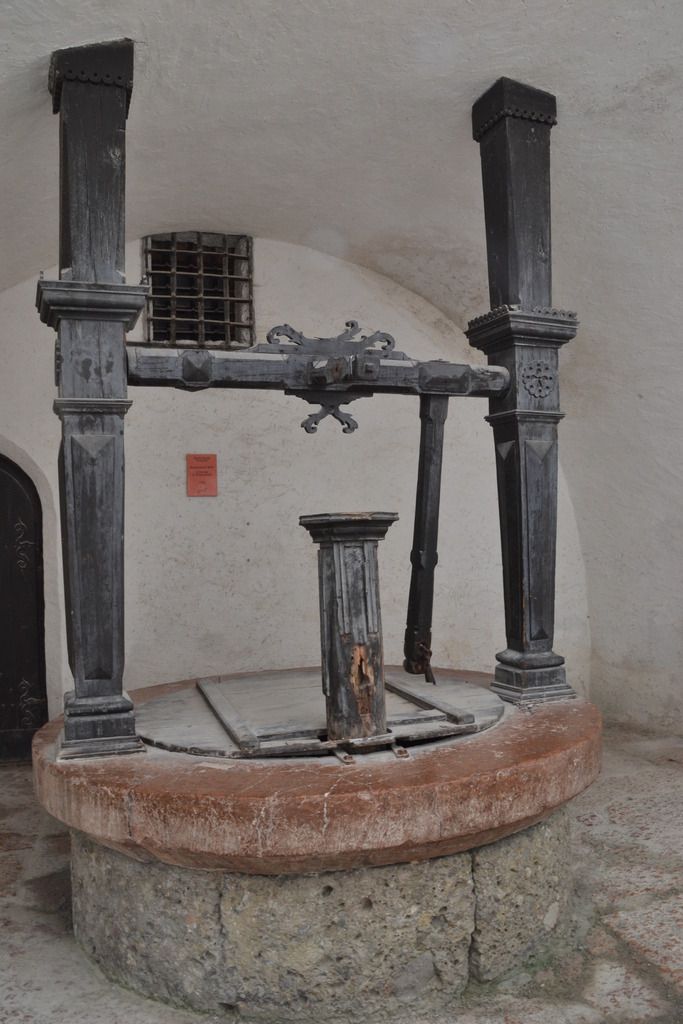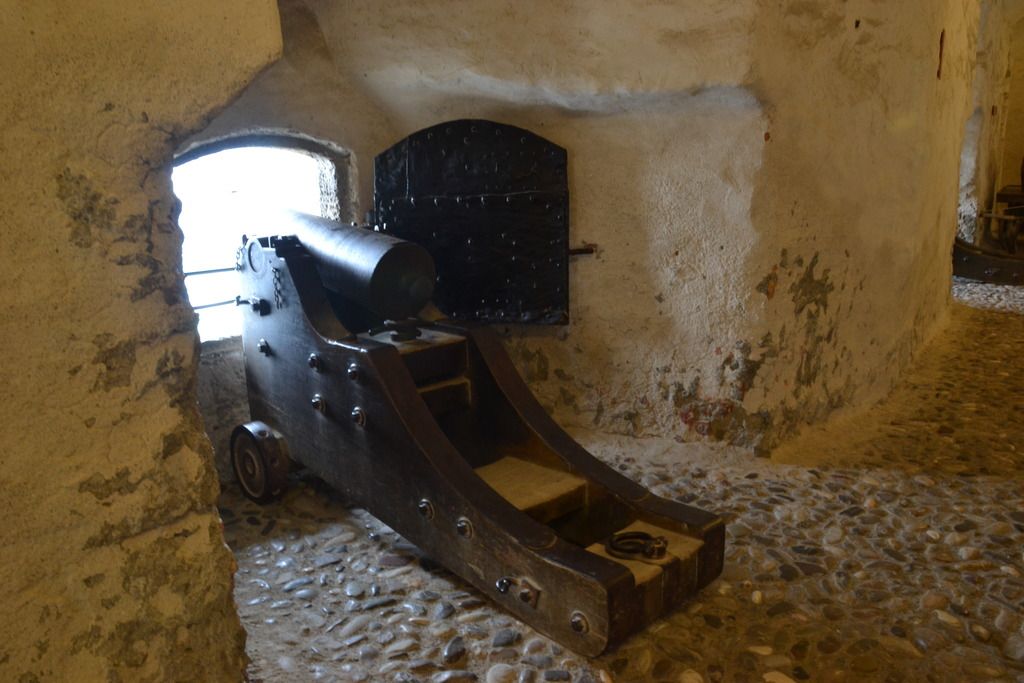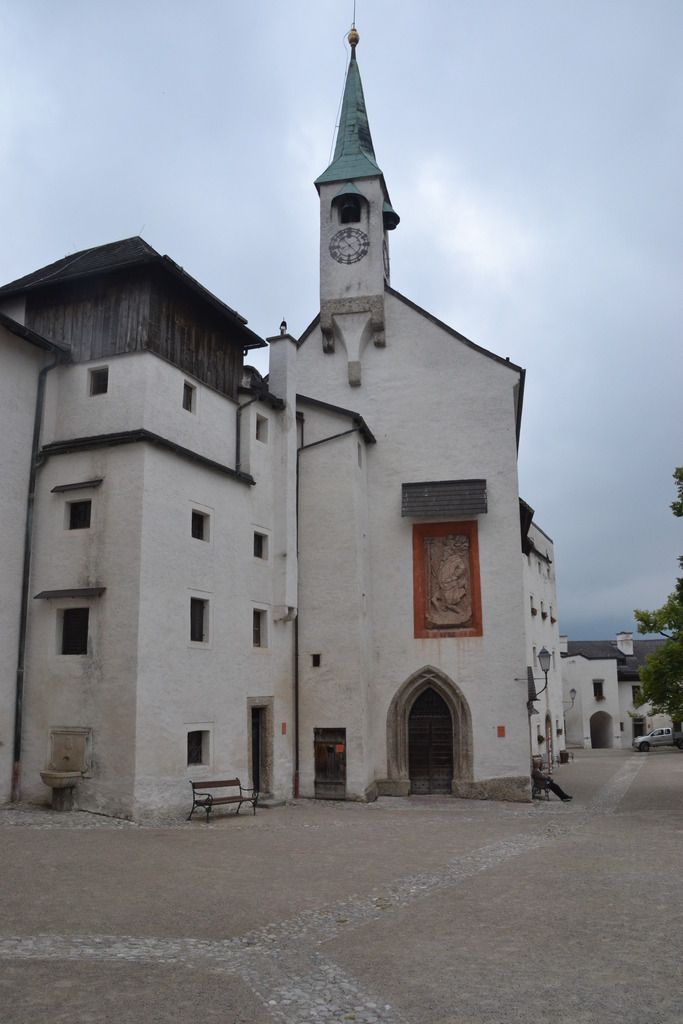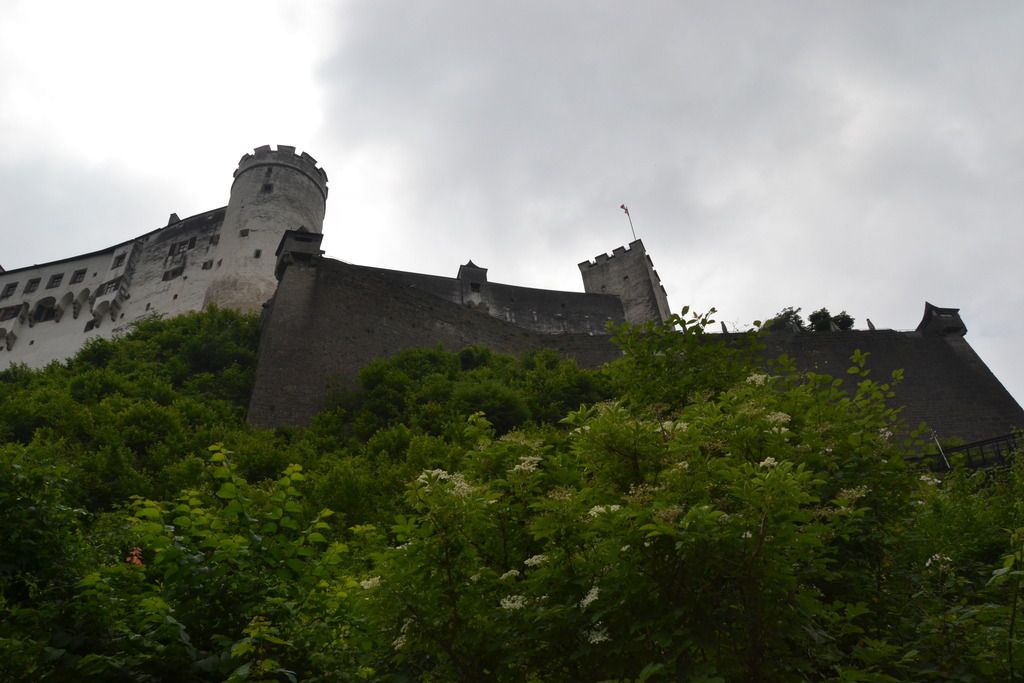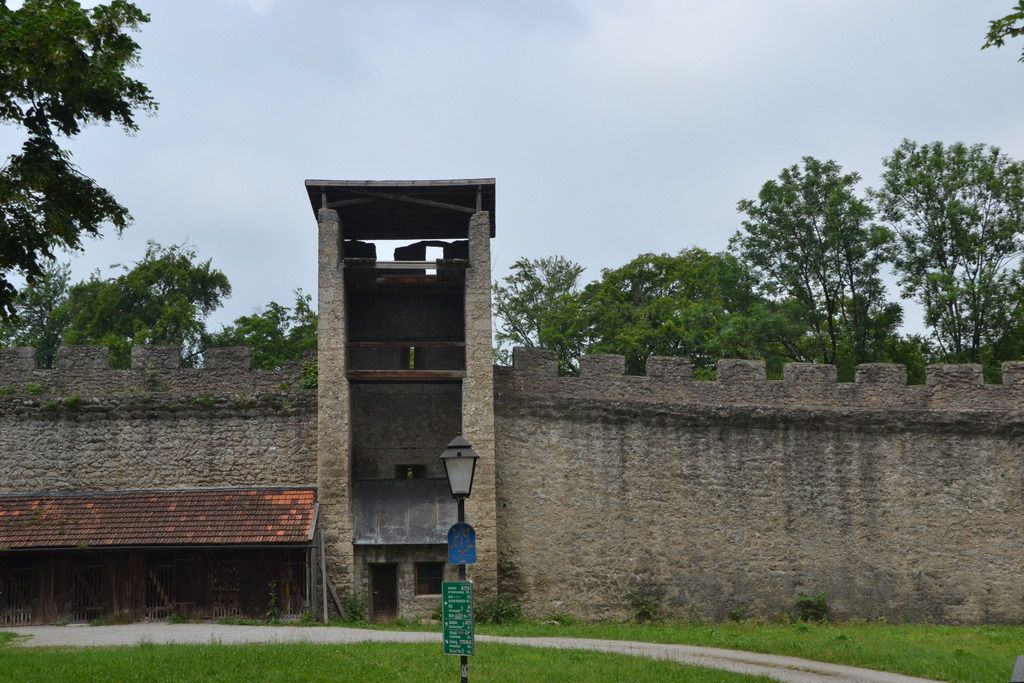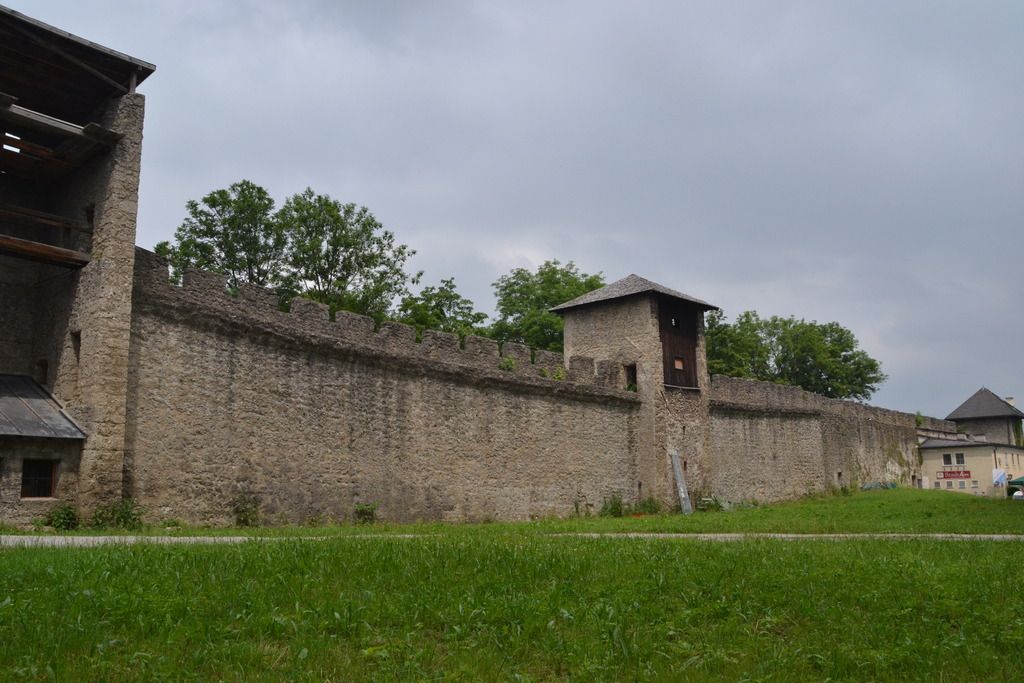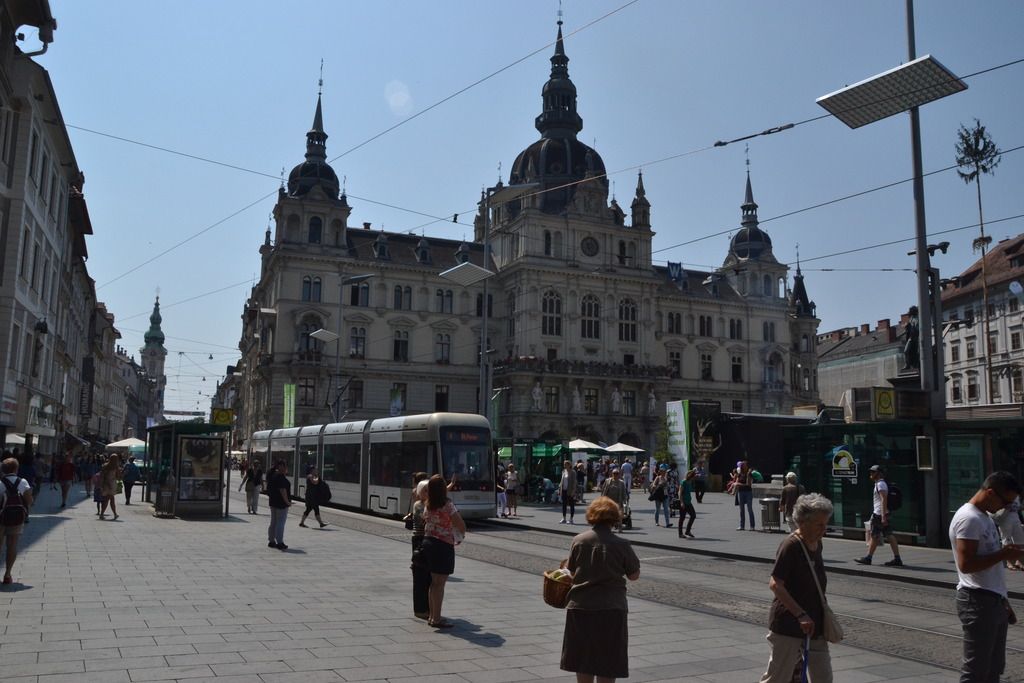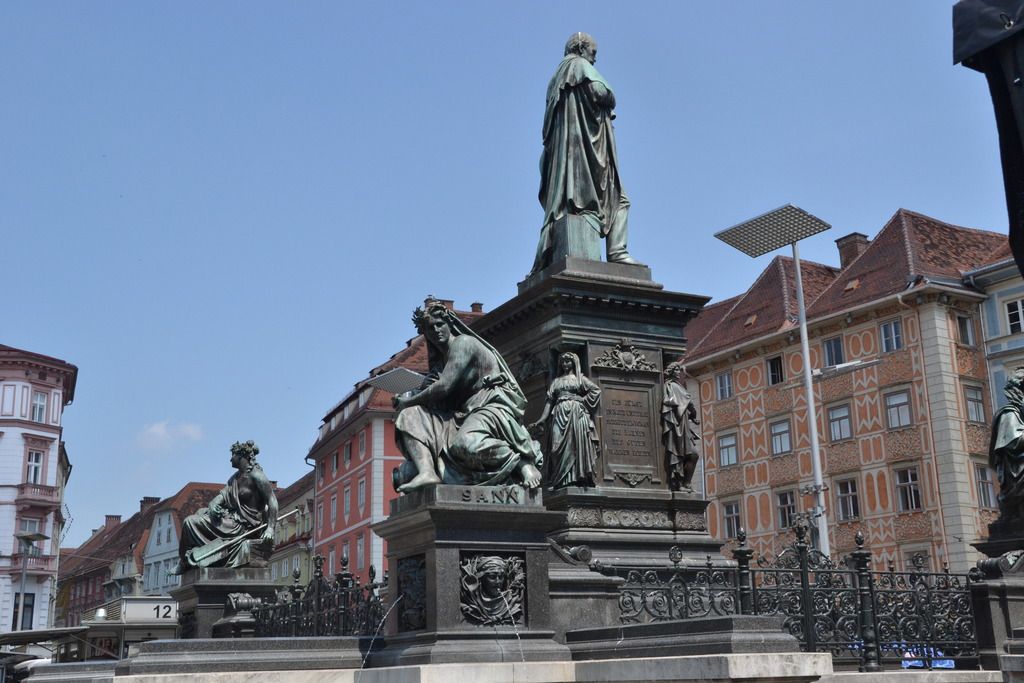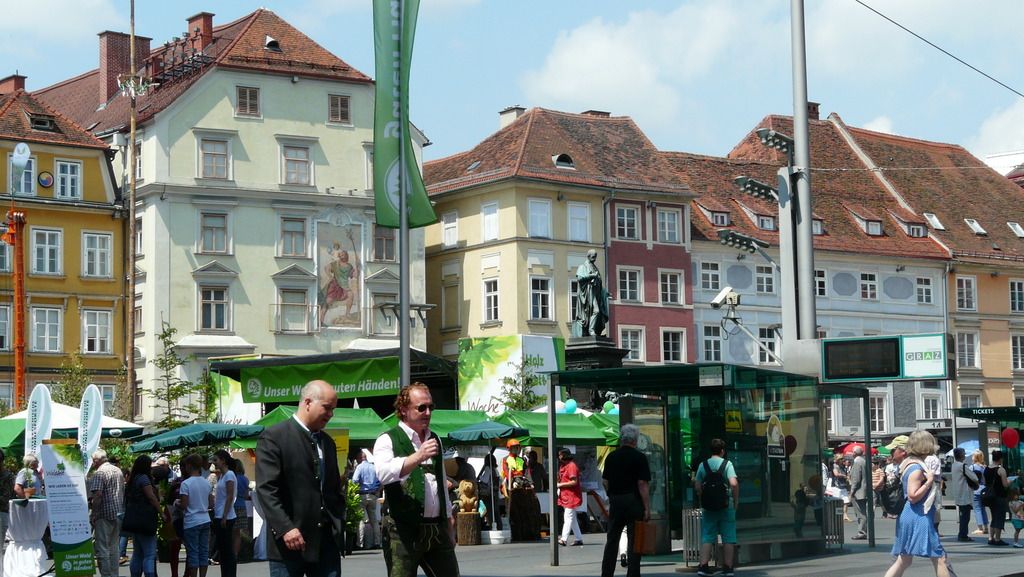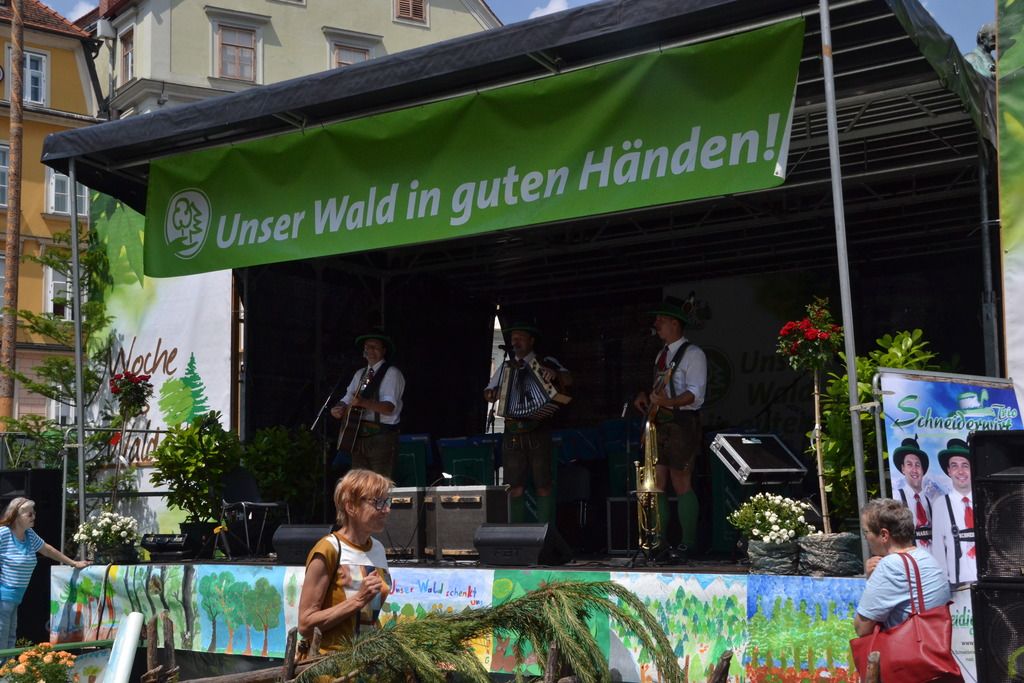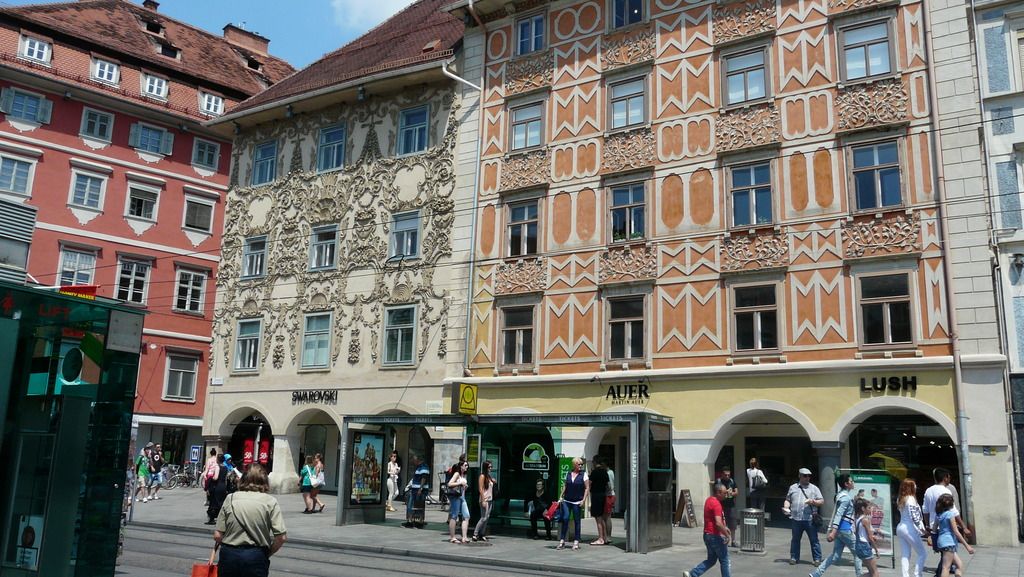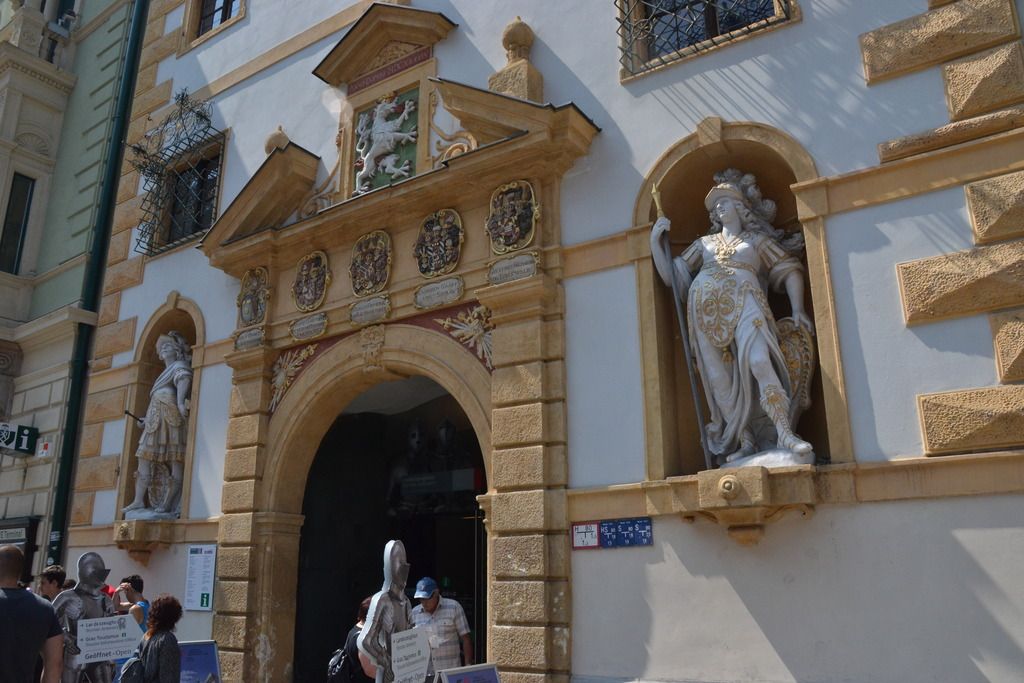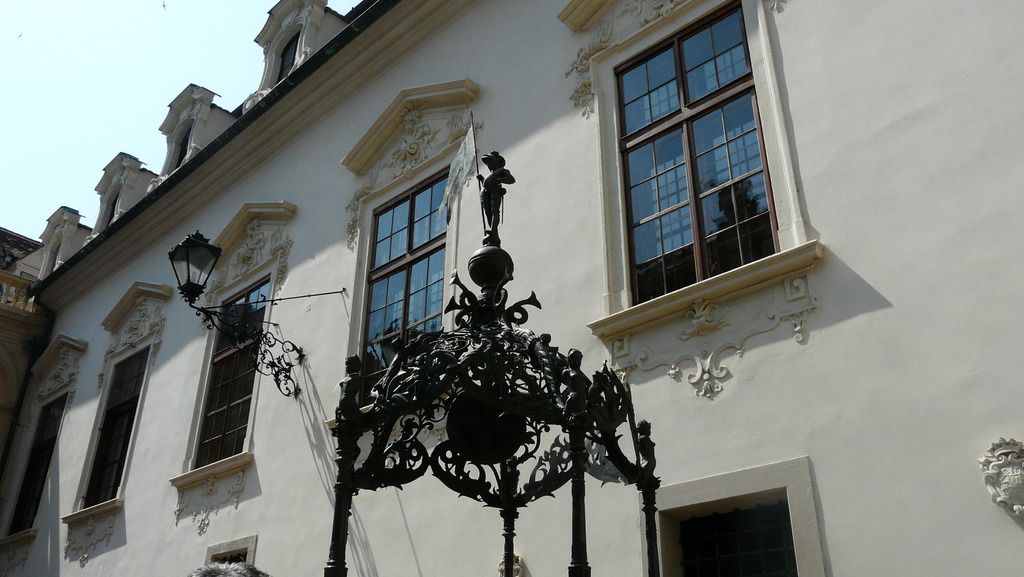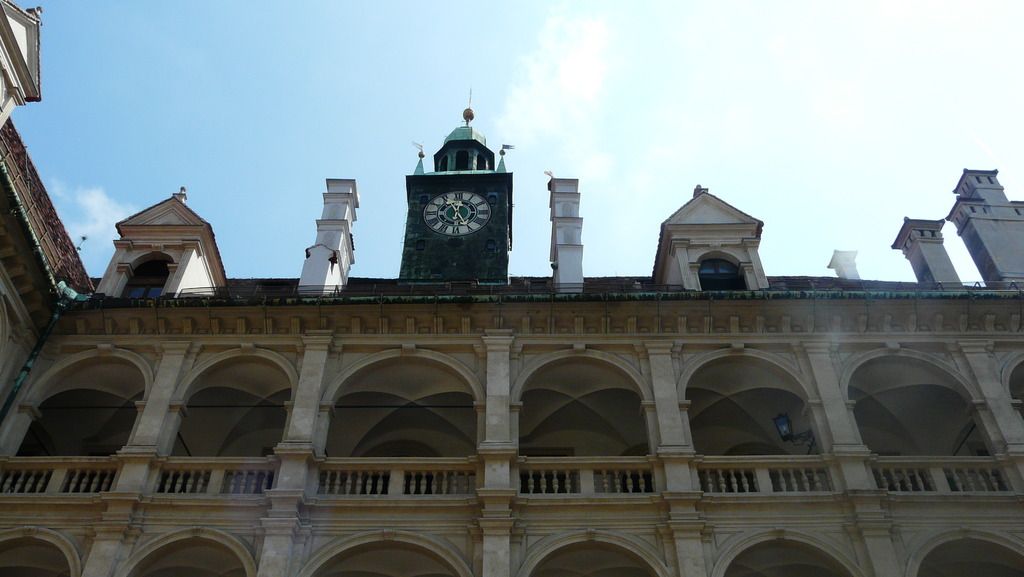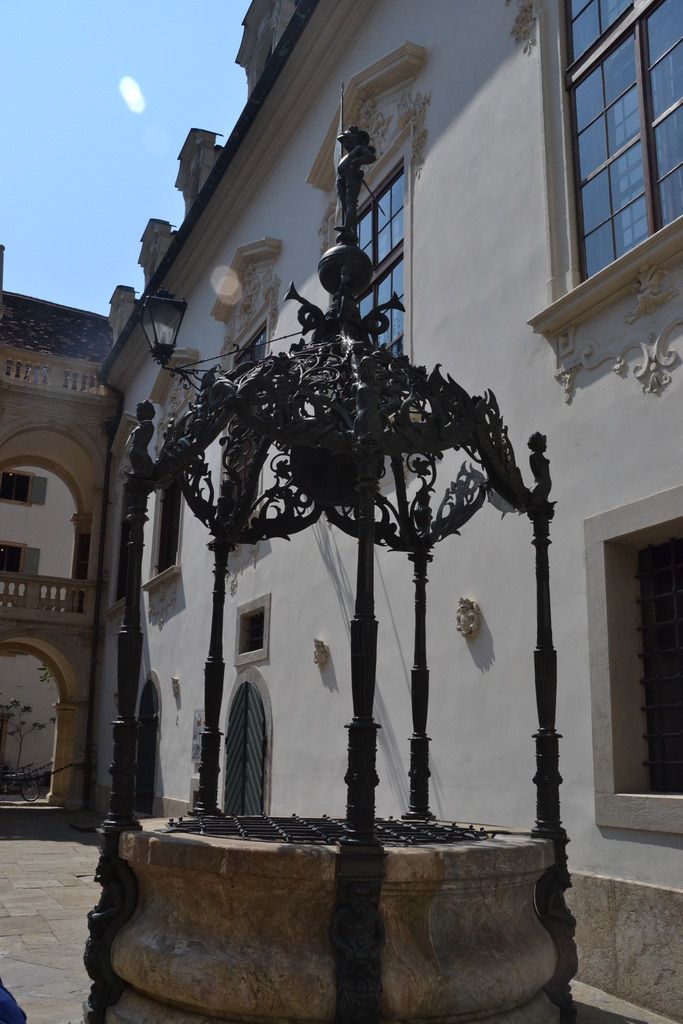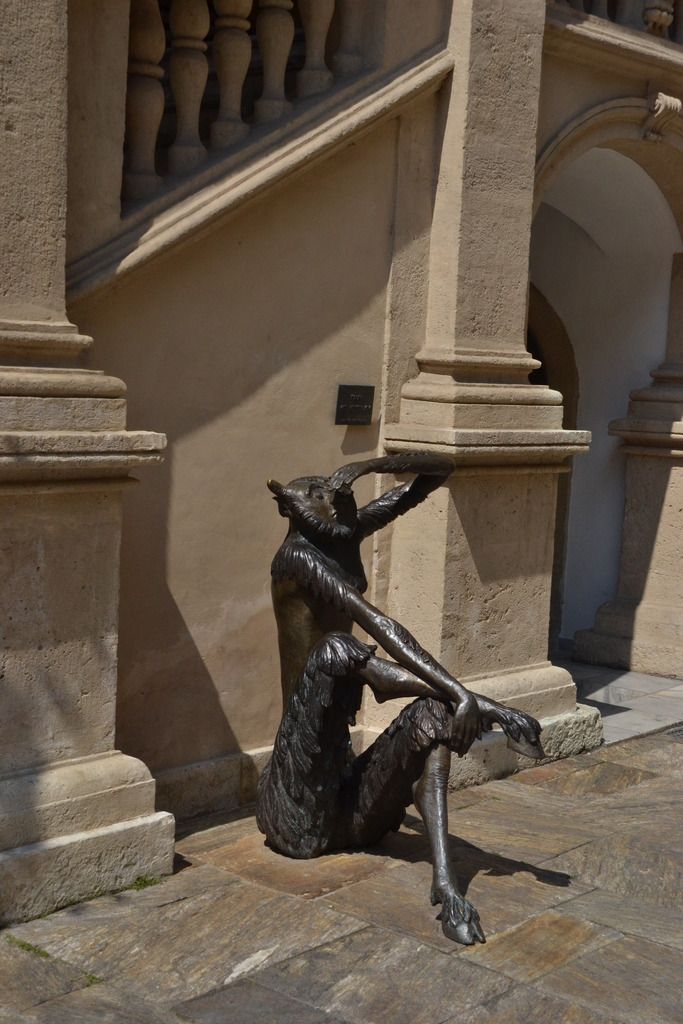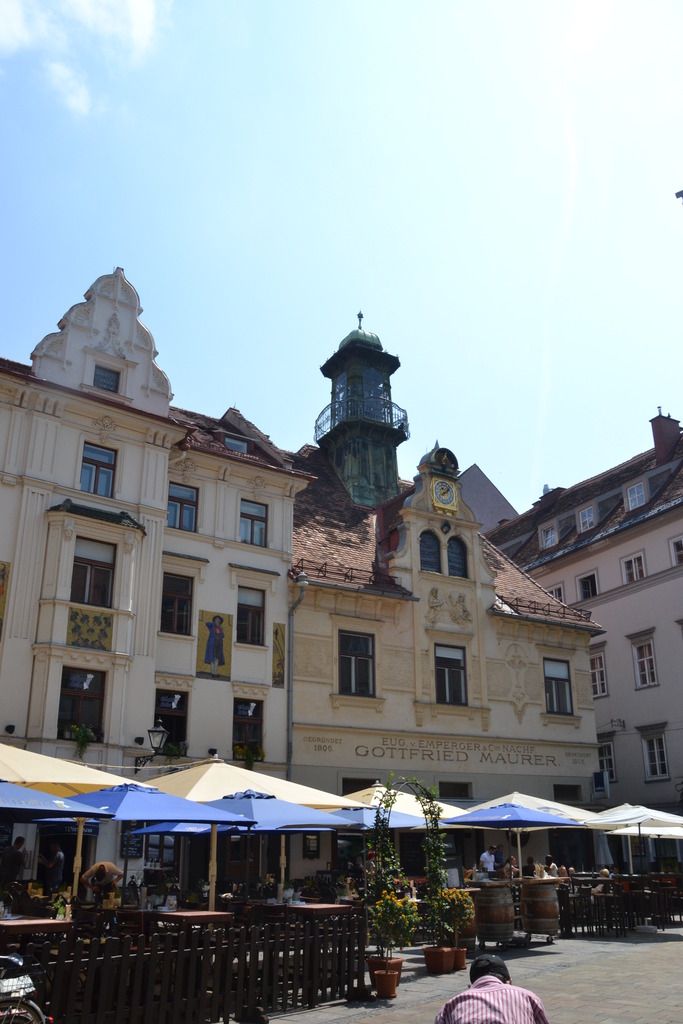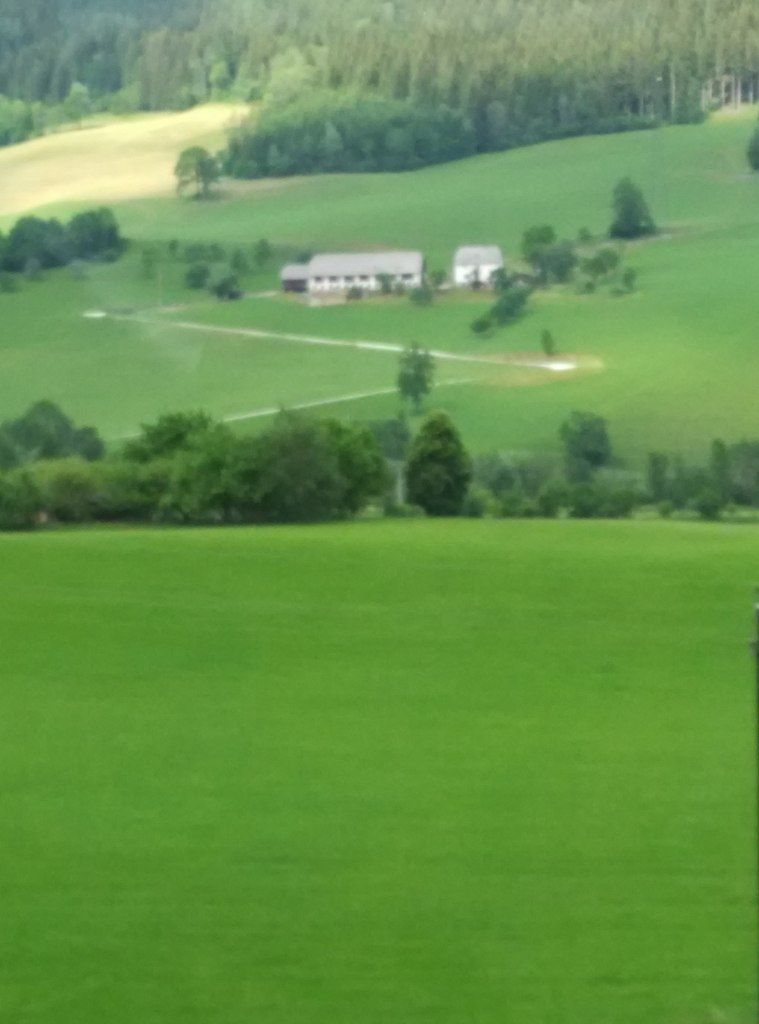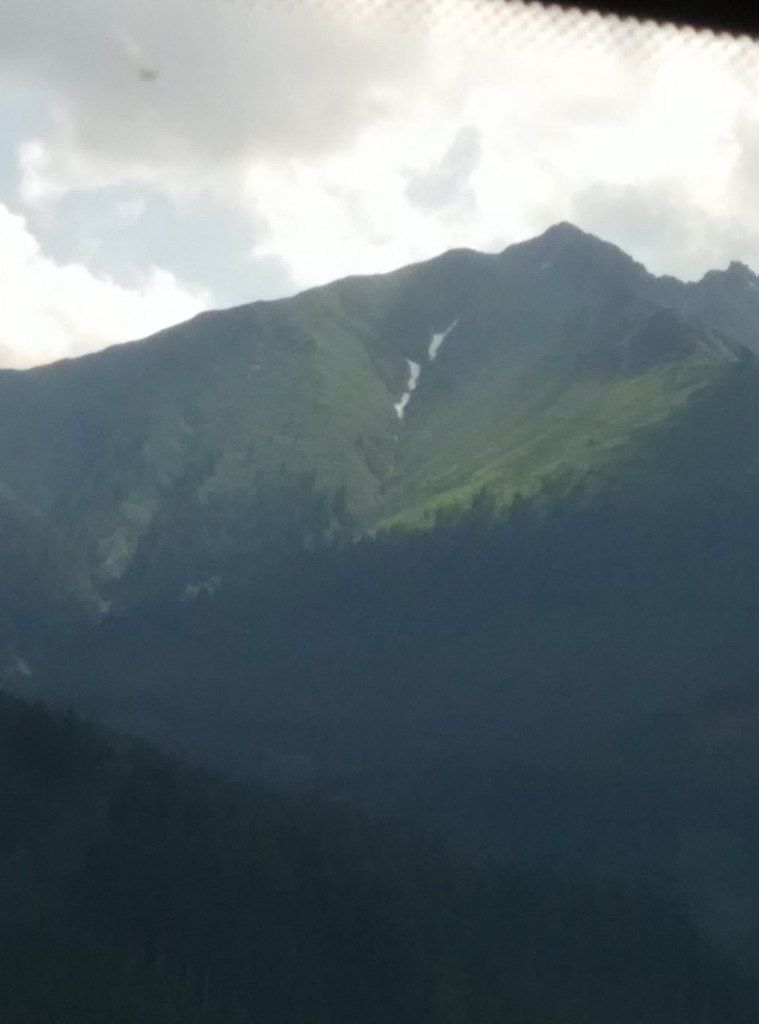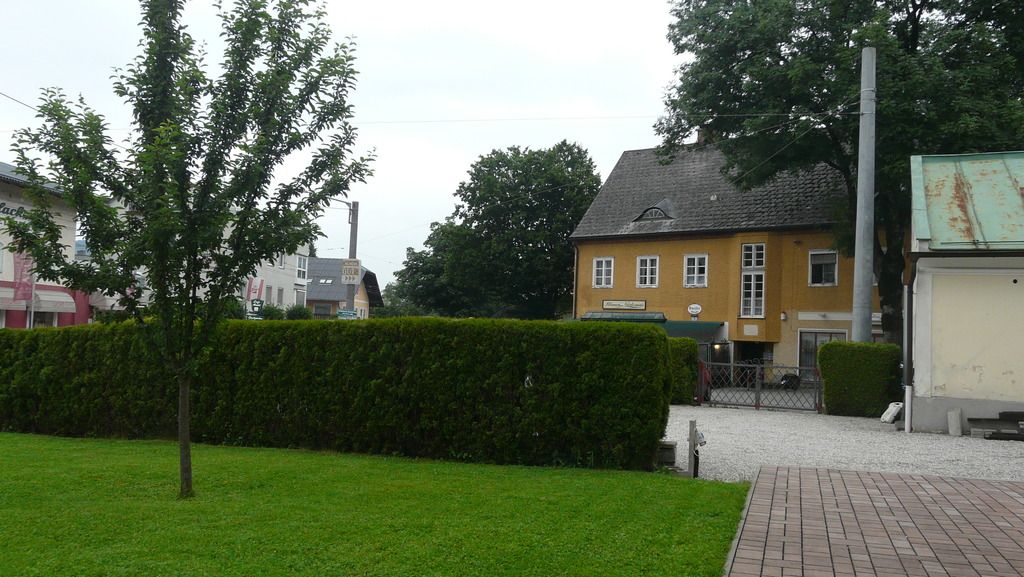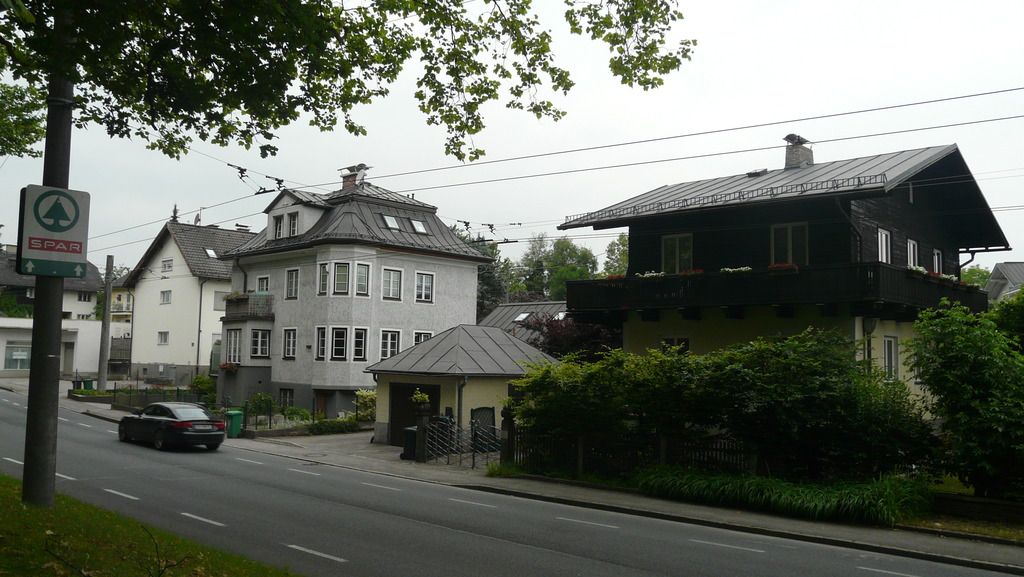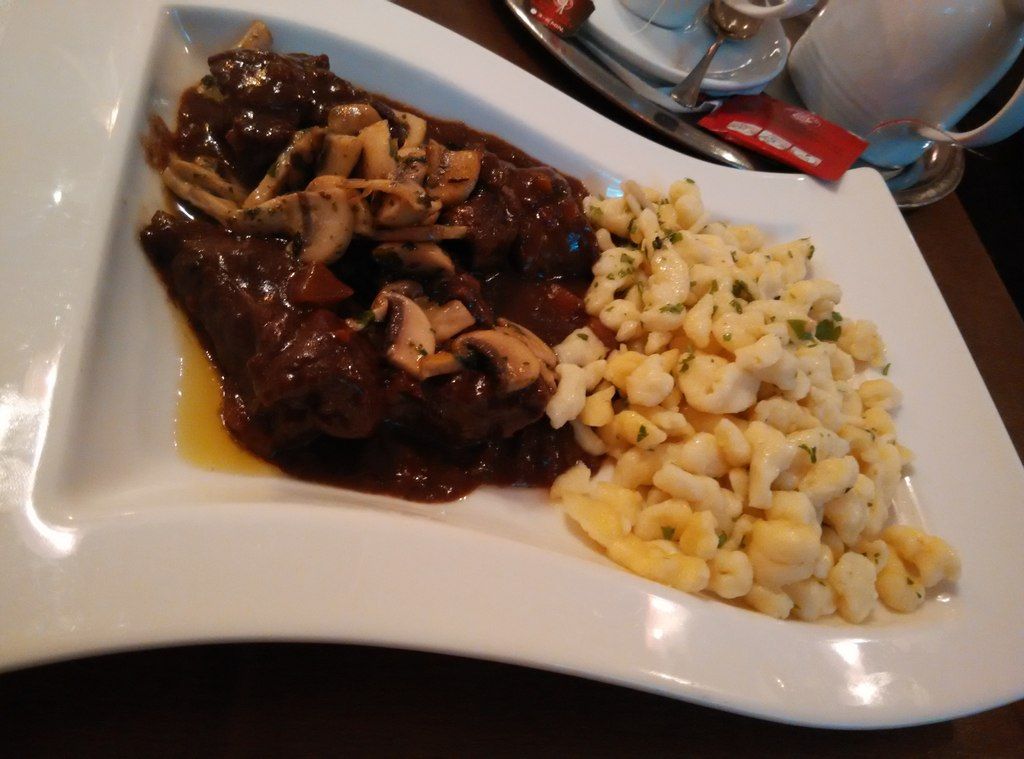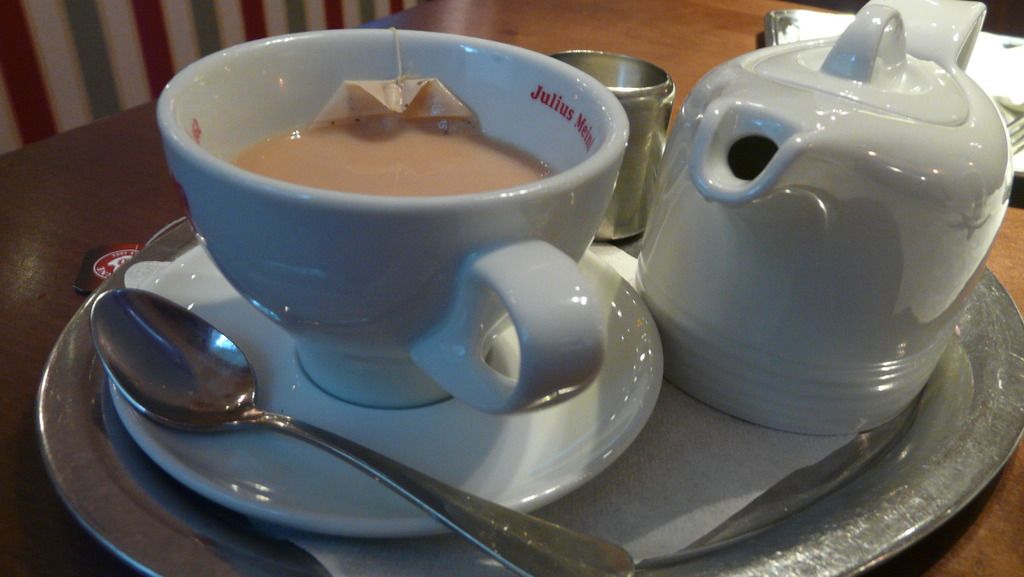It was dark when I woke up. I liked looking out the window, contemplating the view and grading it from spectacular to deadly dull. Two similar brick and concrete building stood outside my window, separated by a modest parking-lot. A cul-de-sac at the far end linked this area to the street outside. Beyond this was a smaller arched gate to the silent walled cemetery. The gates were ornate. Think Haunted Mansion, Transylvania, Count Dracula and you'll know what I mean. I shivered. The chill was not imaginary.
I cannot see myself living in a house like this. Its walls, cold and dank, seemed to whisper dark secrets in conspiratorial tones. Shadows lurked at the corners away from the prying reaches of the dim neon glow. Attached bathrooms are such a blessing. If I have to leave my room in the middle of the night to get to the bathroom, I probably won't.
By 6 am, all was bright and gay outside so we went for a walk. A French couple in their fifties sat on the solitary bench by the main door. We exchanged greetings and smiles and explored the little lawn. There wasn't much to see. The neighborhood was a quiet one. A few cars drove past us occasionally and that was just about all the life that stirred around us.
The dining room was closed until 8 am although Herbert was pottering in the kitchen. We returned to our room, whipped out our tablets and tapped the time away.
Hearing footsteps on the wooden stairs at about 8 am, we left our room accordingly. The dining room was opened. The tables were set. Gargantuan croissants, ham slices, buns, cheeses were laid out on the table. We had a hearty meal washed down with strong brews of coffee and tea. We were asked how we wanted our eggs. Mr Nice-Guy preferred them hard-boiled while the rest of us requested for half-boiled, which Herbert politely reaffirmed as "soft-boiled".
The dining room was quiet. We were seated on four adjoining tables by the corner, divided from the kitchen by a wall. The next table was occupied by the French couple we met this morning. Another woman breakfasted alone on the table by the window. A younger woman sat alone on the adjacent table close to the door. The other diners ate silently, chatting in low whispers as did we.
The eggs arrived soon after, each on an egg holder. Now there were certain table manners to be observed for eating soft-boiled eggs served in an eggcup. The shell at the top of the egg is cracked with a knife horizontally, all around the egg. The tip of the knife is used to lift the shell from the egg. This is placed on the side of the plate. Because the exposed part of the egg is relatively flat, if a dab of butter is placed on it, the butter melts and flows over the egg. A mound of salt and pepper is made on the side of the plate. With a tea spoon, a bite of egg is scooped from the shell and dipped into the seasonings. Alternatively, a pinch of salt and pepper may be sprinkled over each bite by hand. Only after this elaborate ritual are the eggs sent to the mouth.
We learned by example, don't we? As a little kid growing up in a small town, I had had on various occasion seen old men eating half-boiled eggs in public. They lifted the eggs with their fingers, crack 'em in half by knocking it against the rim of the coffee cup, then drop the gooey stuff onto a little plate which came with the morning coffee. A sprinkle of pepper and a splash of soy sauce and the eggs are swallowed with gusto.
I cannot see myself living in a house like this. Its walls, cold and dank, seemed to whisper dark secrets in conspiratorial tones. Shadows lurked at the corners away from the prying reaches of the dim neon glow. Attached bathrooms are such a blessing. If I have to leave my room in the middle of the night to get to the bathroom, I probably won't.
By 6 am, all was bright and gay outside so we went for a walk. A French couple in their fifties sat on the solitary bench by the main door. We exchanged greetings and smiles and explored the little lawn. There wasn't much to see. The neighborhood was a quiet one. A few cars drove past us occasionally and that was just about all the life that stirred around us.
The dining room was closed until 8 am although Herbert was pottering in the kitchen. We returned to our room, whipped out our tablets and tapped the time away.
Hearing footsteps on the wooden stairs at about 8 am, we left our room accordingly. The dining room was opened. The tables were set. Gargantuan croissants, ham slices, buns, cheeses were laid out on the table. We had a hearty meal washed down with strong brews of coffee and tea. We were asked how we wanted our eggs. Mr Nice-Guy preferred them hard-boiled while the rest of us requested for half-boiled, which Herbert politely reaffirmed as "soft-boiled".
The dining room was quiet. We were seated on four adjoining tables by the corner, divided from the kitchen by a wall. The next table was occupied by the French couple we met this morning. Another woman breakfasted alone on the table by the window. A younger woman sat alone on the adjacent table close to the door. The other diners ate silently, chatting in low whispers as did we.
The eggs arrived soon after, each on an egg holder. Now there were certain table manners to be observed for eating soft-boiled eggs served in an eggcup. The shell at the top of the egg is cracked with a knife horizontally, all around the egg. The tip of the knife is used to lift the shell from the egg. This is placed on the side of the plate. Because the exposed part of the egg is relatively flat, if a dab of butter is placed on it, the butter melts and flows over the egg. A mound of salt and pepper is made on the side of the plate. With a tea spoon, a bite of egg is scooped from the shell and dipped into the seasonings. Alternatively, a pinch of salt and pepper may be sprinkled over each bite by hand. Only after this elaborate ritual are the eggs sent to the mouth.
We learned by example, don't we? As a little kid growing up in a small town, I had had on various occasion seen old men eating half-boiled eggs in public. They lifted the eggs with their fingers, crack 'em in half by knocking it against the rim of the coffee cup, then drop the gooey stuff onto a little plate which came with the morning coffee. A sprinkle of pepper and a splash of soy sauce and the eggs are swallowed with gusto.
I knew some etiquette had to be followed when the eggs arrived but I could not remember the detail. The egg does not leave the egg cup.You just have to figure out how it's done. A tea spoon laid on the plate beside the cup. Surmising that this was the proper tool for the occasion, I lifted the teaspoon and tapped the top of the egg to make it crack. (Remember that the dining room is quiet.) The French couple who was seated on the next table across from ours choked on their croissants. I knew I have erred. My husband (bless his soul) intervened to correct the situation. After two or three scoops, I found it troublesome and gave up the egg altogether.
Meanwhile, Ms Walk-Faster, who was seated across from me was a lot more practical. She lifted the egg from the egg cup with her fingers, gave the cup a quizzical glance, then knocked the egg against the cup, making quite a ruckus. The French couple on the next table behind her burst into laughter which they quickly stiffled by sneaking behind their napkins. I was a tad embarrassed. There were tears in their eyes. They did not know that I was watching them.
Herbert was an amiable man. A tall, broad shouldered man in his early forties, he left his vocation as an IT consultant of some sort, to focus on the B &B business his father bequeathed to him. He had a pleasant personality and took pains to make sure we were comfortable. After breakfast, he told us how his father, a soldier settled in Salzburg after the war and founded Pension Herbert and a cafe nearby to tap on the tourist industry.
Herbert was an amiable man. A tall, broad shouldered man in his early forties, he left his vocation as an IT consultant of some sort, to focus on the B &B business his father bequeathed to him. He had a pleasant personality and took pains to make sure we were comfortable. After breakfast, he told us how his father, a soldier settled in Salzburg after the war and founded Pension Herbert and a cafe nearby to tap on the tourist industry.
Our group could not reach a decision about the mountains. Seeing that it was strongly recommended by Herbert's wife, some of us were keen to see them for ourselves. The three young-uns argued back and forth.
"I will not join you today if you're driving to the mountains. I think I'll stay back in my room to rest because my head is heavy and I can feel a fever coming any time soon," I said, not wishing to be caught with a fever up there where the hills are alive with the sound of music!
After a moment's silence, the issue was settled. The number 5 bus will take us downtown Salzburg from where we could always return should the occasion called for it. We withdrew to our respective rooms to prepare for the day's adventure. The bus stop was a stone's throw from Pension Herbert. Herbert's wife who took the same bus helped us identify the bus stop on our side of the Salzach river from where we began our walk by first crossing a small metal bridge featured in The Sound of Music.
FORTRESS HOHENSALZBURG (SALT FORTRESS)
|
|
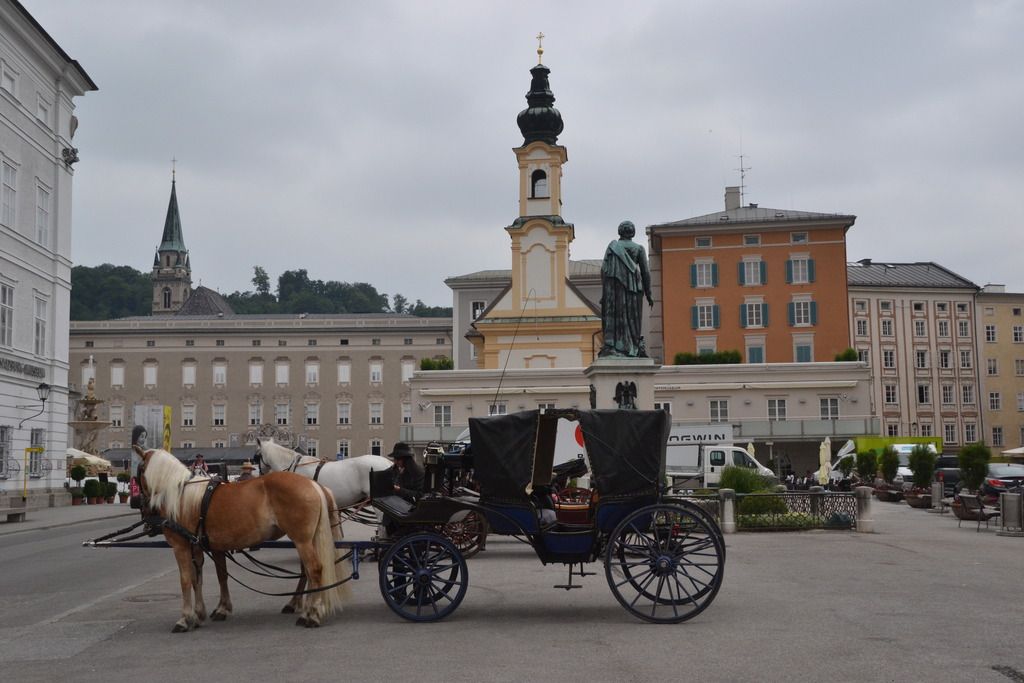 |
| Mozartplatz |
Salzburg (meaning "Salt Fortress") is a city of dreaming spires. During the 8th century, barges carried salt on the Salzach river (subject to toll) from the south. Mines that were rich in salt, gold and other ores enabled the Prince Archbishops to finance the elaborate architecture that made Salzburg a UNESCO World Cultural Heritage site. Architects were imported from various other cities and the Baroque building boom left the city with a large number of palaces, towers and churches. Sacred monuments outnumbered secular buildings so Salzburg became known as "Rome of the North".
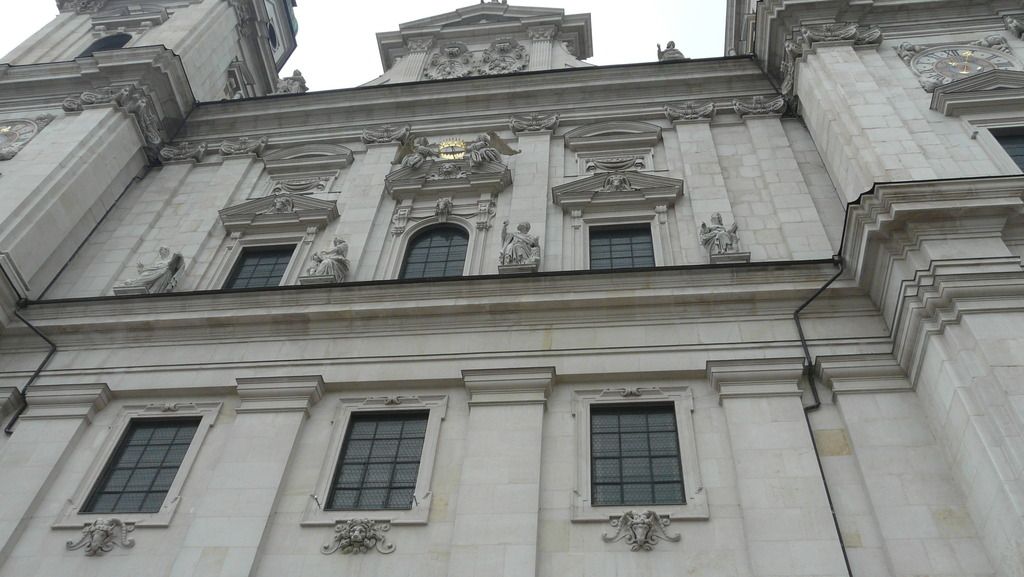 |
| Salzburg Cathedral |
|
|
|
|
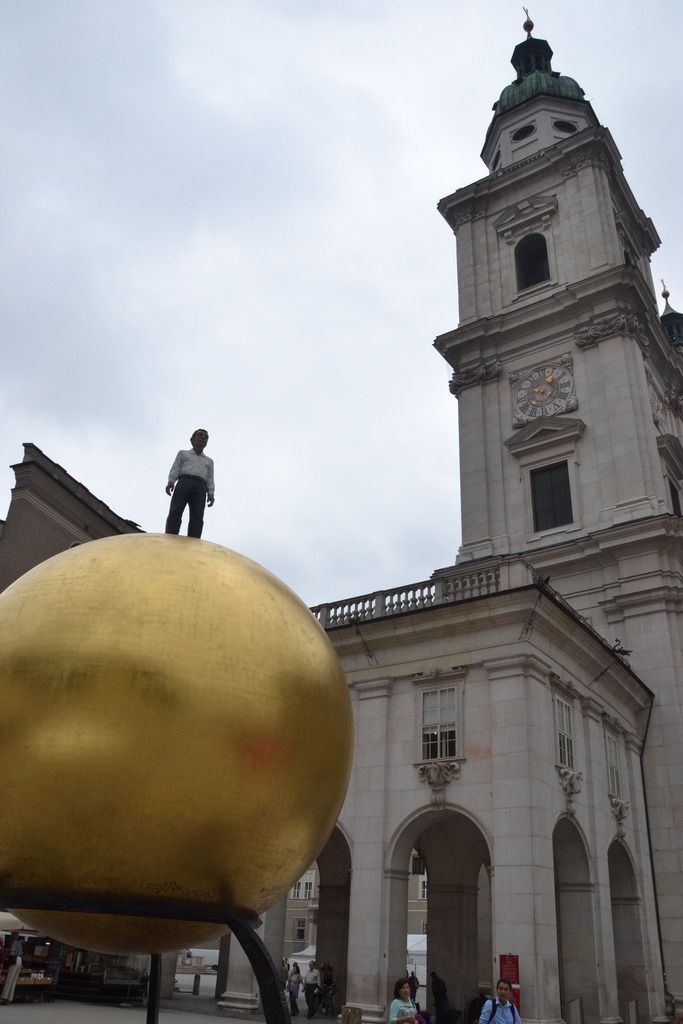 |
There were something like five interconnecting squares and a whole lot more to see. We wandered aimlessly from one square to the other until we came upon this man standing on a golden orb, gazing up at the castle.
We had arrived at Kapitelplatz.
This was a 2007 piece of public art commissioned by a foundation
|
A group of tourists were queuing up for the funicular service. We joined the queue to get our tickets after which we were herded into a small cable car which dragged us up to the Fortress.
|
|
 |
| Taken from a bench where I was resting at the Fortress |
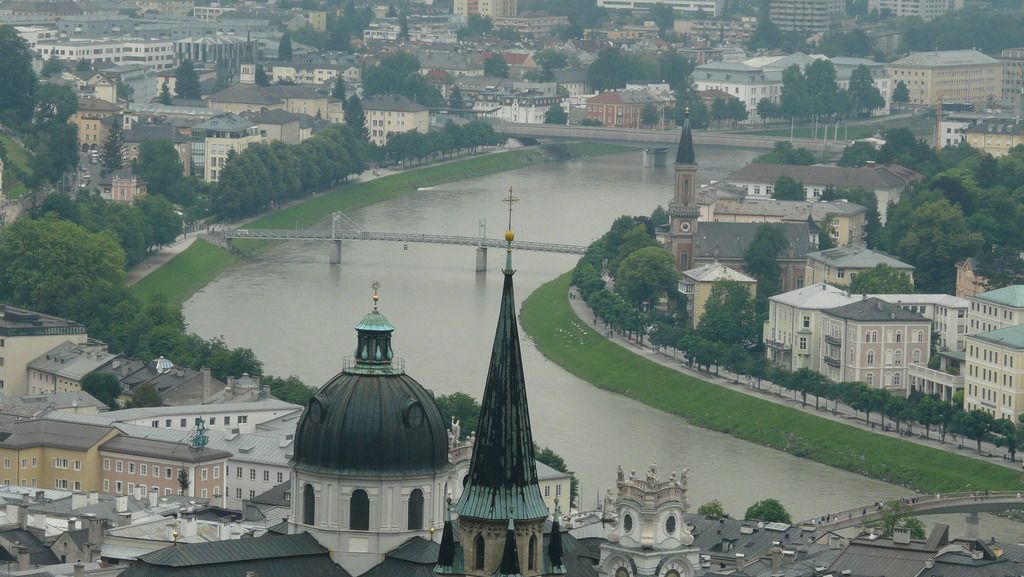 |
| Salzach River |
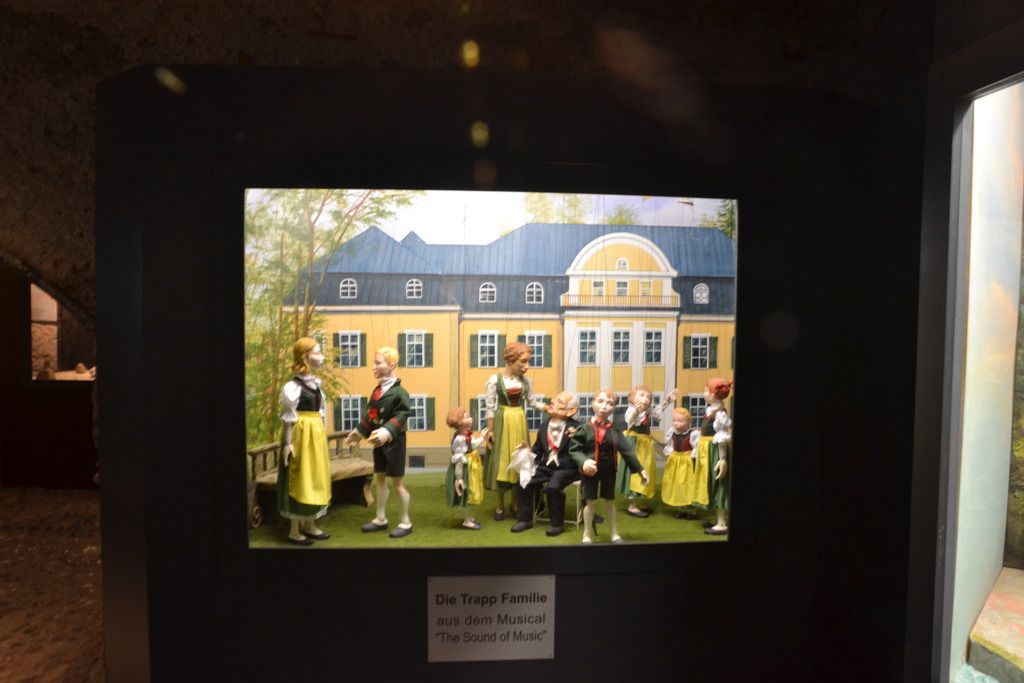 |
| Sound of Music |
| 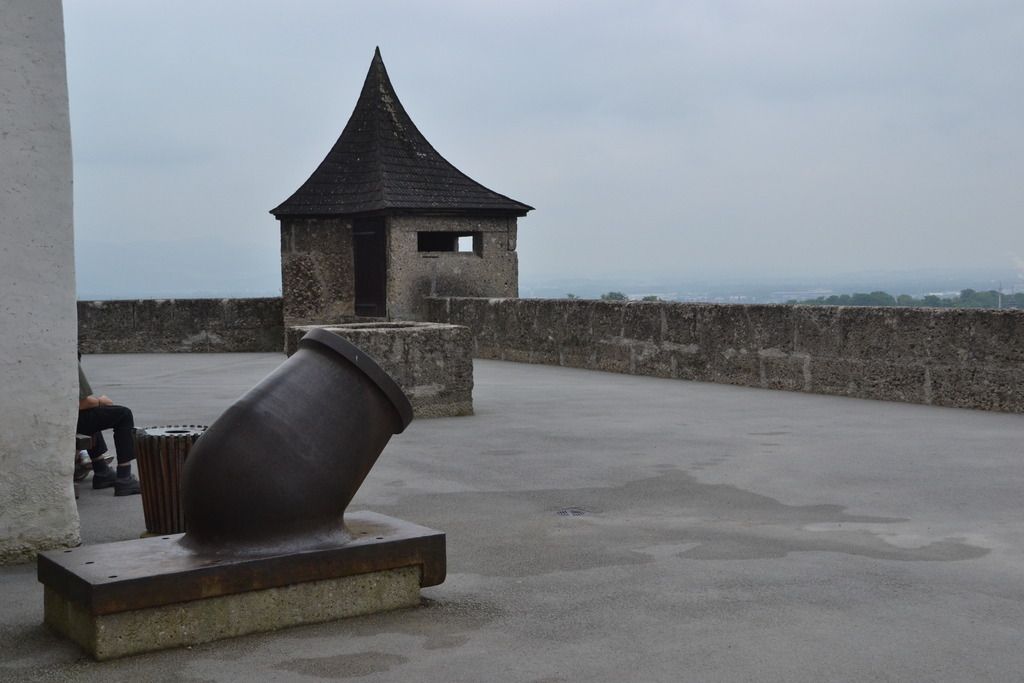 |
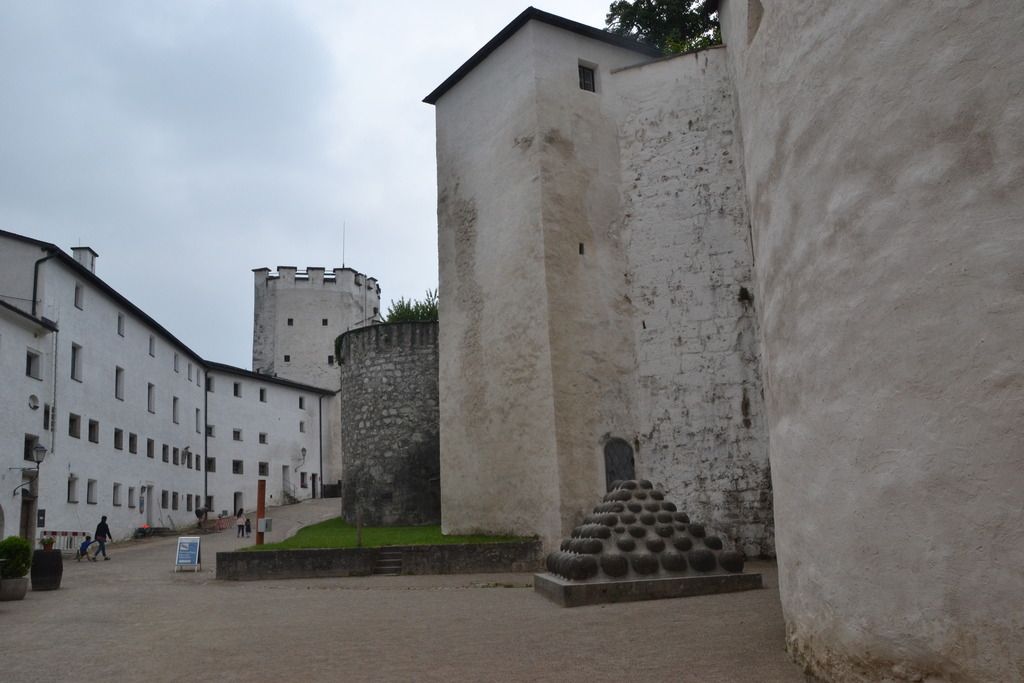 |
| Kuenburg Bastion |
FESTUNGSBERG HIKE
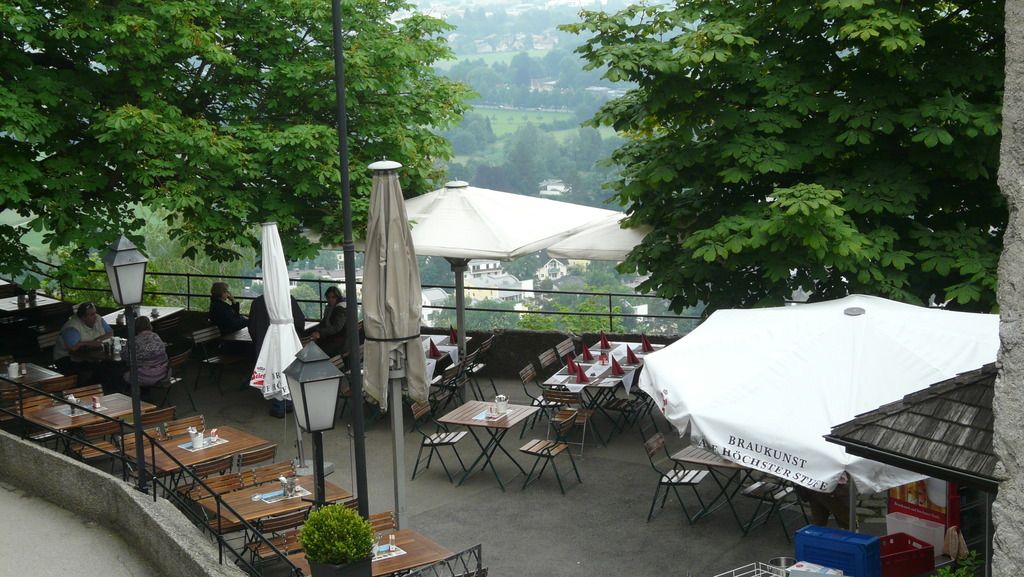 The fortress was extensive. After wandering around aimlessly and pointing our cameras at anything that doesn't move, we reached the back part of the fortress. A cafe restaurant occupied this space. It had a beautiful view. Now under normal circumstances, I would have liked to stop for a cuppa. However, the rest of us were anxious to keep moving, so we kept moving, walking along the hiking path on the Festungsberg Mountains where the Fortress is situated.
The fortress was extensive. After wandering around aimlessly and pointing our cameras at anything that doesn't move, we reached the back part of the fortress. A cafe restaurant occupied this space. It had a beautiful view. Now under normal circumstances, I would have liked to stop for a cuppa. However, the rest of us were anxious to keep moving, so we kept moving, walking along the hiking path on the Festungsberg Mountains where the Fortress is situated.
|
|
|
|
The scenery was spectacular. I would have enjoyed this walk had it not been for the backward glances from Ms Walk-Faster. I had not intended to delay them but there I was huffing and puffing from the effort of keeping up. It was cold on this day so I had worn a track bottom which wasn't a good idea because the fabric was rubbing against the bruises on my knee. The hiking path wound around the Festungsberg Mountains, climbing and descending gentle slopes.
Mr Nice-Guy (bless his soul) was most considerate. Aware that we were lagging behind, he slowed down his pace to engage in a casual chat with his friend. (They were old school chum, you understand?)
Ms Walk-Faster turned around, noticed her husband way, way at the back with us, stopped in her tracks and waited for us to catch up. When we were within ear-shot, she chided her husband.
"Why are you walking so slowly? The children are far away in front. They won't wait for you!"
A tad contrite, I urged Mr Nice-Guy to go ahead, telling him we'll return to the hotel on our own. My head was heavy and my eye-lids were burning, indicating of course, that a fever is just around the corner.
"Mummy ... why do you talk this way?" Mr Nice-Guy groaned as he picked up his pace. Our two groups separated.
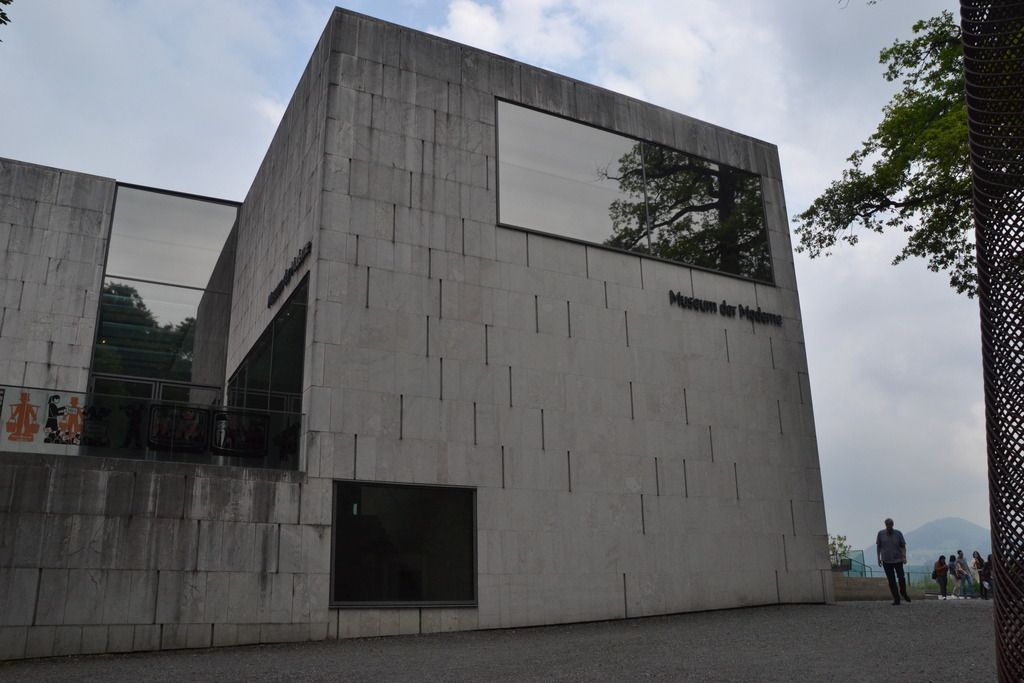 |
| Museum der Modene |
The old town below was something else. I was feeling ill and in no mood to take pictures. Outdoor cafe restaurants occupied an open space with trams and buses operating on the outer perimeter. The tables were placed close to each other. We took a table outside an Italian restaurant at the open square. The air was so thick you could cut it with a knife. We were surrounded by smokers of all size and denomination. I was quite ready to crash, so we decided to return to the hotel with packed lunch instead. Along a narrow lane adjacent to the Italian restaurant was a little bakery managed by a middle-aged woman. We packed some chicken kebab sandwiches and asked her for direction to the nearest bus stand from where we could board the no: 5 bus. We were just two streets away. We followed the crowd until we found ourselves on a long narrow street running parallel to the river in the center of town. I leaned on the wall outside a grocery while my husband picked up some lemons. (for our sore-throat) Stopping at the nearest bus stand, we waited for Number 5 to appear.
We reached Pension Herbert at 1 pm. I dropped my bag, crashed feverishly onto the bed and was sound asleep in no time.
It was 3.30 pm when I woke up with the hunger pangs. After lunch (chicken kebab sandwiches), I dropped back to sleep until dinner. (packed hot-dogs from the cafe down the road) I went back to bed after dinner. The coughing spasms began.
Oh ... Woe is me!
There was so much to see in Salzburg. We did not explore all the squares near the Salzburg Cathedral. Nor did we see Mozart's house, where he was born. We missed the Mirabell Garden, where Maria and the Trapp kids (The Sound of Music) ran down the hedge arcade. Oh ... and the mountains!
Now that I have recovered from the flu, I wished that I could turn back time just to see a little bit more of Salzburg, just a little bit more ... but that would be asking for too much, wouldn't it?
Now that I have recovered from the flu, I wished that I could turn back time just to see a little bit more of Salzburg, just a little bit more ... but that would be asking for too much, wouldn't it?
